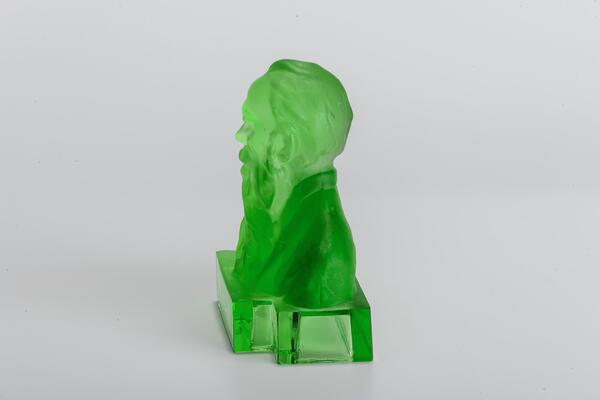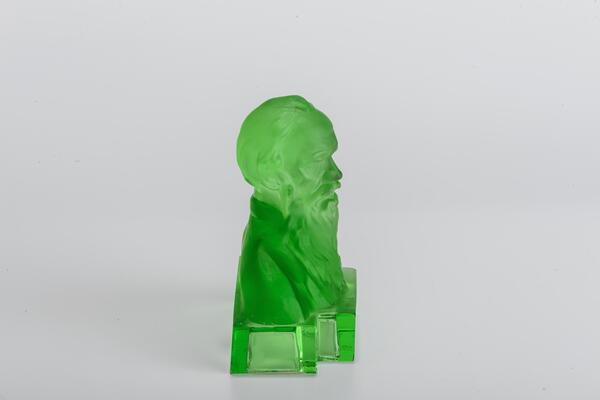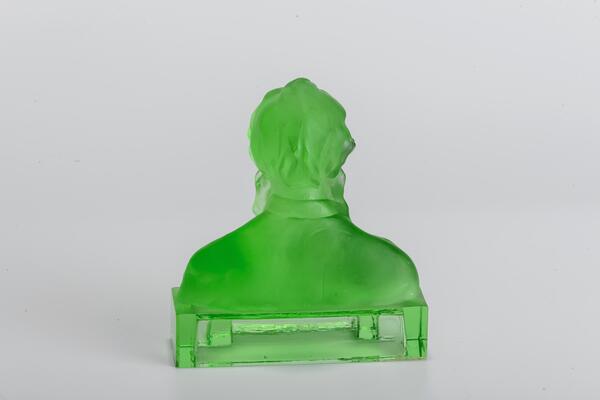The bust paperweight depicting Leo Tolstoy commemorates the visit that the writer paid to the village of Nikolo-Pestrovka in 1869.
Anna Petrovna Bakhmeteva, née Tolstaya, was married to the third owner of the Nikolsko-Bakhmetevsky glass factory. By the time of the writer’s visit, she was already a widow. Together, they visited the enterprise and Tolstoy left with samples of crystal glassware made by the best Nikolsky craftsmen.
In 1910, the first version of a commemorative glass paperweight featured a T-shaped mount with the bust of the writer on top. The mount was made of transparent uranium glass. This type of glass is colored with uranium compounds and fluoresces bright green under ultraviolet light. However, lead glass does not fluoresce, as it absorbs ultraviolet light. The bust is frosted. The essence of frosting technology is the opposite of polishing: it is used to create a roughened matt finish on the surface of the entire product or an opaque pattern on the selected part of the glass.
The sketch for the paperweight was created by the plant’s artist Adele Yakovlevna Yakobson. She based it on a plaster model, which she, most likely, had brought from Europe. The model was improved to take into account the cast iron mold, which was used for glass products.
The paperweight — the bust of Tolstoy — was mentioned in the price lists of 1911 and then 1924 under the “stationery” heading. Apparently, the item was produced while each of those price lists was valid. In 1940, on the 30th anniversary of Leo Tolstoy’s death, the bust was released again at the “Red Giant” factory. The replica was repeated for the third time in 1958, on the 130th anniversary of the classic author.
In total, the museum houses eight busts: five of them arrived at different times from the factory, and three were donated to the museum. The items differ in color: the green and two colorless ones are on display, and the rest are dark blue, rosaline, purple and milk glass. Half of the copies are frosted — this technique makes the writer’s features look softer. The mounts of colorless paperweights have an inscription in italics — “Leo Tolstoy”.
Anna Petrovna Bakhmeteva, née Tolstaya, was married to the third owner of the Nikolsko-Bakhmetevsky glass factory. By the time of the writer’s visit, she was already a widow. Together, they visited the enterprise and Tolstoy left with samples of crystal glassware made by the best Nikolsky craftsmen.
In 1910, the first version of a commemorative glass paperweight featured a T-shaped mount with the bust of the writer on top. The mount was made of transparent uranium glass. This type of glass is colored with uranium compounds and fluoresces bright green under ultraviolet light. However, lead glass does not fluoresce, as it absorbs ultraviolet light. The bust is frosted. The essence of frosting technology is the opposite of polishing: it is used to create a roughened matt finish on the surface of the entire product or an opaque pattern on the selected part of the glass.
The sketch for the paperweight was created by the plant’s artist Adele Yakovlevna Yakobson. She based it on a plaster model, which she, most likely, had brought from Europe. The model was improved to take into account the cast iron mold, which was used for glass products.
The paperweight — the bust of Tolstoy — was mentioned in the price lists of 1911 and then 1924 under the “stationery” heading. Apparently, the item was produced while each of those price lists was valid. In 1940, on the 30th anniversary of Leo Tolstoy’s death, the bust was released again at the “Red Giant” factory. The replica was repeated for the third time in 1958, on the 130th anniversary of the classic author.
In total, the museum houses eight busts: five of them arrived at different times from the factory, and three were donated to the museum. The items differ in color: the green and two colorless ones are on display, and the rest are dark blue, rosaline, purple and milk glass. Half of the copies are frosted — this technique makes the writer’s features look softer. The mounts of colorless paperweights have an inscription in italics — “Leo Tolstoy”.




